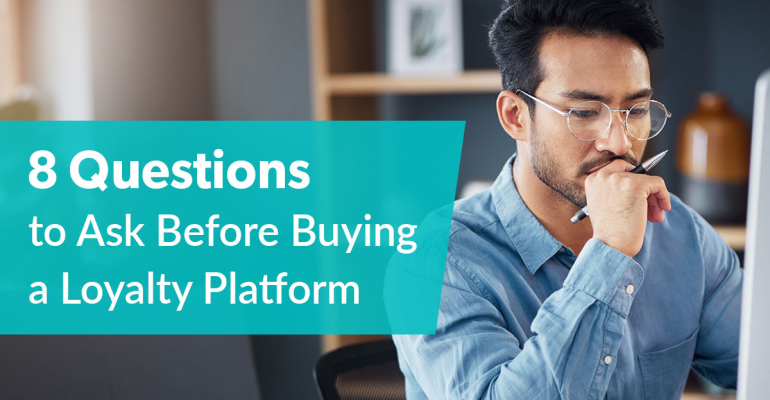Restaurant loyalty programs are increasingly a requirement to drive traffic, foster loyalty and compel guests to order direct. But choosing the right technology to support your brand’s business goals requires careful consideration. While it may be tempting to focus on specific features, the actual business impact delivered is what is most important. With that in mind, here are eight crucial questions to ask before investing in (or switching to) a new loyalty platform:
1. Loyalty programs are about creating sustained customer loyalty — driving foot traffic, spend and greater profitability. That’s why the most important question to ask any loyalty platform provider is “how has the platform positively impacted frequency, customer retention and profitability for other restaurants like mine? Can you share examples?”
2. Loyalty members who make three purchases are 10 times more likely to make another purchase. But in reality, most loyalty participants never reach that elusive third purchase. Why? Because activation of newly acquired customers is difficult to do and most loyalty platforms don’t make it easy. That’s why you must ask, “Does the platform have easy to use tools to encourage new loyalty members to be active in the program? What customer activation rate (customers with at least three purchases in the first 180 days) should we expect to achieve on your platform in the first year?”
3. Most brands spend way more time on acquisition than retention despite the fact that the average quick-service restaurant (QSR) has an 84% retention rate MoM. That means, even leading restaurants who outperform the benchmark and achieve a 90% monthly retention rate will still have no active users within a year unless they add more people than they lose. That’s scary. But also, hopefully, motivating. Ask each platform provider, “Does the platform have features to drive retention and encourage the return of lapsed guests, and if so, how do they work? What retention rate (percentage of customers who have made a purchase in the last 180 days) can we expect to achieve on your platform in the first year?”
4. Great loyalty programs offer the highest value to the most valuable customers and don’t waste valuable dollars on less profitable ones. But it’s impossible to know exactly what your costs will be when you launch a new program. That’s because your effective discount rate changes based on how many rewards are redeemed. A loyalty structure should offer the flexibility to make adjustments to the program at any time. Ask your loyalty platform provider, “How does the platform track and monitor the cost of rewards? How will I know if a reward drives cost-effective frequency and engagement, and can I adjust my program to fine-tune the cost-to-value ratio?”
5. On this same note, not every perk that will be valued by a customer requires a discount. Reducing the Effective Discount Rate (EDR) can be achieved by integrating non-discount-based rewards into your loyalty program. These rewards have a higher probability of boosting engagement, cutting expenses, and enriching the overall loyalty program experience for all customers. Ask your loyalty provider, “What types of non-discount rewards can customers redeem with their loyalty points (hidden menus, exclusive events/merchandise, charitable donations, etc.), and what impact has this non-promotional approach had on your effective discount rate? Can you provide examples of customers who have leveraged these types of rewards and the associated outcomes?”
6. Loyalty programs can have a massive impact on digital revenue if integrated correctly into the ordering experience. Not only can a loyalty program draw customers from third-party channels to order on first-party channels improving margins, but they can also drive upsell and repeat visits. Ask, “How does the loyalty program integrate with online ordering and delivery services, and what lift in digital revenue can we expect as a result of the program? Could you provide case studies and/or testimonials from restaurants that have successfully integrated your loyalty program with our specific online ordering system?”
7. Many restaurants are moving away from legacy loyalty platforms, but there is a hidden cost that comes with a poorly managed transition from the existing membership program. A successful program launch with a seamless transition should massively increase engagement and membership. Ask, “What is the step-by-step process for transitioning an existing loyalty program? Are there examples of how existing members will experience the transition? What percentage of active customers can I expect to transition, and do you offer reporting for monitoring this transition?”
8. Last but not least, loyalty programs are not a one-and-done. It’s important to foster long-term engagement with ongoing offers and promotions through omni-channel marketing. To make sure you are constantly improving marketing returns, ask, “Does the platform allow for true A/B testing of both one-time and automated marketing campaigns? What is the end-to-end process for A/B testing a marketing campaign? What revenue impact can I expect from A/B testing?”
Understanding and improving how the loyalty platform delivers business impact will allow your loyalty program to compete more effectively with alternatives and deliver meaningful impact to your business. Carefully analyzing the answers to these eight questions is a great start to helping you find the loyalty platform that best aligns with your business goals and customer expectations.
Interested in learning more about how to buy restaurant loyalty software? Check out this comprehensive guide to restaurant loyalty platforms, which contains all 100 questions you should ask before investing.
 AUTHOR BIO
AUTHOR BIO
Zach Goldstein is the CEO and Founder of Thanx. Founded in 2011, Thanx is a guest engagement and retention platform helping become more digitally agile to maximize customer lifetime value. Prior to earning his MBA from Stanford, Goldstein honed his experience in the customer loyalty space at Bain & Company, helping companies perfect their retention and reward strategies as early as 2005.

